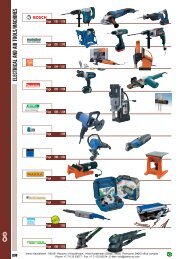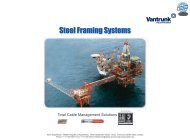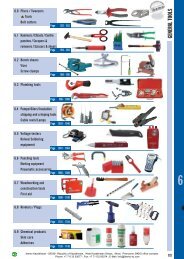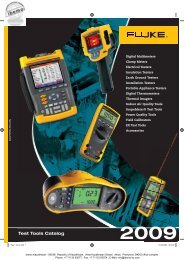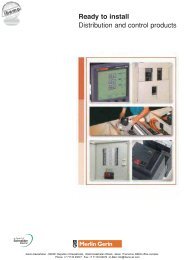- Page 1 and 2:
1.0 Drilling and centring tools Pag
- Page 3 and 4:
! Application data calculation Term
- Page 5 and 6:
Steel codes Material No. DIN Materi
- Page 7 and 8:
Overview of types Twist drill bits
- Page 9 and 10:
Overview of types Step drill bits /
- Page 11 and 12:
10 010 Twist drill bits rolled, ste
- Page 13 and 14:
Ø d1 10 015... 10 017... l1 l2 Ø
- Page 15 and 16:
10 031 Twist drill bit sets in meta
- Page 17 and 18:
10 043 Twist drill bits for long to
- Page 19 and 20:
10 054 Deep hole twist drill bits v
- Page 21 and 22:
10 064 Twist drill bits for high cu
- Page 23 and 24:
10 068 Twist drill bits for drillin
- Page 25 and 26:
10 091 Twist drill bit boxes, empty
- Page 27 and 28:
10 105 Twist drills, extra short 10
- Page 29 and 30:
10 110 Twist drills, extra short Hi
- Page 31 and 32:
10 142 Car body drill bit Robust an
- Page 33 and 34:
10 152 Twist drill bit, long for dr
- Page 35 and 36:
10 156 Twist drill bit, long high c
- Page 37 and 38:
10 162 Twist drill bit, long Twist
- Page 39 and 40:
10 219 Deep hole twist drill bit, e
- Page 41 and 42:
10 315 Twist drill bits for long to
- Page 43 and 44:
10 325 Twist drill bits Twist drill
- Page 45 and 46:
10 386 Deep hole twist drill bits v
- Page 47 and 48:
10 424 HSS subland drill bits Nitri
- Page 49 and 50:
10 431 Core drill bits with QuickIN
- Page 51 and 52:
10 452 Centre drill bits 10 452…
- Page 53 and 54:
10 474 NC spot drill bits with spir
- Page 55 and 56:
10 485 NC spot drill bits Type as 1
- Page 57 and 58:
10 513 Spotweld remover bit Prefera
- Page 59 and 60:
10 522 Step drill bits With steady
- Page 61 and 62:
Overview of types VHM twist-drill b
- Page 63 and 64:
10 550 Solid carbide twist drill bi
- Page 65 and 66:
10 553 Solid carbide metal twist dr
- Page 67 and 68:
10 558 VHM thread drilling tool the
- Page 69 and 70:
Guideline values for ALPHA4Plus Mic
- Page 71 and 72:
Ø d1 10 564... 10 565... 10 566...
- Page 73 and 74: Ø d1 10 569… d2 l1 l2 l4 mm mm m
- Page 75 and 76: 10 573 Solid carbide cooling duct t
- Page 77 and 78: Ø d1 10 581… d2 l1 l2 l4 mm mm m
- Page 79 and 80: 10 583 Solid carbide cooling duct t
- Page 81 and 82: 10 593 Solid carbide cooling duct t
- Page 83 and 84: 10 603 Solid carbide cooling duct d
- Page 85 and 86: 10 602 Sintered carbide twist drill
- Page 87 and 88: 10 660 Sintered carbide SDS hammer
- Page 89 and 90: 10 682 Tool holder shanks without c
- Page 91 and 92: 11 101 Countersink bit, single poin
- Page 93 and 94: 11 118 Countersink bit sets Content
- Page 95 and 96: 11 160 Countersink bit axially and
- Page 97 and 98: 11 712 Counterbore bit with paralle
- Page 99 and 100: 11 732 Counterbore bit with paralle
- Page 101 and 102: 11 818 Toolholder size 0 Shank sock
- Page 103 and 104: 11 838 Insert drill bit HSS CO Size
- Page 105 and 106: 11 870 Toolholder Size 2 with inter
- Page 107 and 108: 11 880 Countersink bit for indexabl
- Page 109 and 110: 12 242 Quick release, adjustable ha
- Page 111 and 112: 12 306 Tapered roughing reamers 45
- Page 113 and 114: 12 512 Machine reamers Left-hand sp
- Page 115 and 116: 12 522 NC machine reamers right-han
- Page 117 and 118: 12 533 Machine roughing reamers 45
- Page 119 and 120: 12 622 Sintered carbide machine rea
- Page 121 and 122: Overview of types Hand taps Page Ca
- Page 123: Page Catalogue DIN Flutes Chamfer M
- Page 127 and 128: 13 003 Hand taps Special features:
- Page 129 and 130: 13 007 Hand taps Special features:
- Page 131 and 132: 13 015 Hand tap set 2B Special feat
- Page 133 and 134: 13 023 Hand tap set Special feature
- Page 135 and 136: 13 044 Combined drill bit and taps
- Page 137 and 138: 13 052 Machine taps Application: Ea
- Page 139 and 140: 13 058 Machine taps, left cutting A
- Page 141 and 142: 13 066 Machine taps Application: Ea
- Page 143 and 144: 13 076 Machine taps Application: sh
- Page 145 and 146: 13 079 Fluteless tap Application: M
- Page 147 and 148: 13 085 High-performance fluteless t
- Page 149 and 150: 13 089 Machine taps Type: Applicati
- Page 151 and 152: 13 094 Machine taps Type: Applicati
- Page 153 and 154: 13 117 Machine taps Type: Right-han
- Page 155 and 156: 13 122 Machine taps Type: Right-han
- Page 157 and 158: 13 147 Machine taps Type: Right-han
- Page 159 and 160: 13 151 Machine taps Type: Right-han
- Page 161 and 162: 13 159 Machine taps Type: Right-han
- Page 163 and 164: 13 174 Machine taps Application: Hi
- Page 165 and 166: 13 175 Machine taps Application: Hi
- Page 167 and 168: 13 190 Machine taps Application: Hi
- Page 169 and 170: d1 x pitch mm 13 371... Wodex 13 37
- Page 171 and 172: 13 376 Machine taps Type: Right-han
- Page 173 and 174: 13 410 Machine taps 2B Type: with s
- Page 175 and 176:
13 421 Machine taps 2B Type: Right-
- Page 177 and 178:
13 560 Machine taps Type: with spir
- Page 179 and 180:
13 574 Machine taps Type: Right-han
- Page 181 and 182:
Solid carbide thread milling cutter
- Page 183 and 184:
13 693 Thread milling drill bit for
- Page 185 and 186:
13 695 Indexable insert for 60° th
- Page 187 and 188:
13 705 Dies Thread type: EN 22568 T
- Page 189 and 190:
13 752 Dies Thread type: EN 22568 T
- Page 191 and 192:
13 842 Dies Type: pre-slit Special
- Page 193 and 194:
13 920 Hand tap sets complete in pa
- Page 195 and 196:
13 973 "Tap crown" tap remover for
- Page 197 and 198:
13 993 Cu electrodes for HSS, steel
- Page 199 and 200:
14 003 Metal cutting circular saw b
- Page 201 and 202:
14 058 Metal cutting circular saw b
- Page 203 and 204:
Overview of uses of HSS milling cut
- Page 205 and 206:
15 009 HSS-E narrow side & face slo
- Page 207 and 208:
15 110 Shell end mills with longitu
- Page 209 and 210:
15 206 Long slot drill cutters Suit
- Page 211 and 212:
15 215 Slot drill cutters Suitable
- Page 213 and 214:
15 224 End mill cutter, multi flute
- Page 215 and 216:
15 236 Ball nosed slot drills Suita
- Page 217 and 218:
15 248 Roughing cutters Suitable fo
- Page 219 and 220:
15 260 PM Wodex-Eco milling cutters
- Page 221 and 222:
15 499 HSS-E corner rounding cutter
- Page 223 and 224:
verview of uses of VHM milling cutt
- Page 225 and 226:
Page DIN Shank Coating Type rder Nu
- Page 227 and 228:
15 782 1-flute cutters special geom
- Page 229 and 230:
15 803 “XL” long slot drill cut
- Page 231 and 232:
15 813 Mini-shank/disposal milling
- Page 233 and 234:
15 817 “Uni-alu” slot drill cut
- Page 235 and 236:
15 824 “Uni R” long slot drill
- Page 237 and 238:
15 831 “XL-B” ball nosed copy m
- Page 239 and 240:
15 856 “INOX” roughing cutters
- Page 241 and 242:
15 890 Wodex “UNI” ECO cutters
- Page 243 and 244:
15 868 “50 HRC XXL” multi-tooth
- Page 245 and 246:
15 900 HSC cutters with “HRC 55-L
- Page 247 and 248:
15 910 “HRC 55” HSC torus cutte
- Page 249 and 250:
16 501 Straight lathe tools DIN 497
- Page 251 and 252:
16 536 Wide face square nose turnin
- Page 253 and 254:
16 576 Offset side turning tools DI
- Page 255 and 256:
16 606 60° external thread turning
- Page 257 and 258:
16 650 HSS-Co parting turning tools
- Page 259 and 260:
! Properties of the knurling method
- Page 261 and 262:
16 847 Knurling milling cutter tool
- Page 263 and 264:
16 857 HSS thumbwheels (DIN403) for
- Page 265 and 266:
Turning + parting overview IH Page
- Page 267 and 268:
19 207 PCBN 75° toolholder for ext
- Page 269 and 270:
19 352 CNMG - DM tip medium machini
- Page 271 and 272:
19 662 TCBN 75° toolholder Toolhol
- Page 273 and 274:
19 367 DNMG - WM tip medium machini
- Page 275 and 276:
19 670 TDJN 93° toolholder 19 670
- Page 277 and 278:
19 217 PRDC toolholder for external
- Page 279 and 280:
19 674 TSRN 75° toolholder Toolhol
- Page 281 and 282:
19 405 TNMG - EX tip medium machini
- Page 283 and 284:
19 417 WNMG - DM tip medium machini
- Page 285 and 286:
f 19 275 SCLC 95° boring bars for
- Page 287 and 288:
19 237 Boring bar set A-SDQC-107°
- Page 289 and 290:
19 280 SDUC 93 boring bars for inte
- Page 291 and 292:
19 245 SSDC 45 toolholder For exter
- Page 293 and 294:
19 257 SVVC 72° 30` toolholder For
- Page 295 and 296:
Accessories for 19 256…, 19 259
- Page 297 and 298:
“Safety Products” catalogue Ey
- Page 299 and 300:
f f f 1 1 19 300 “Eco-Cut” for
- Page 301 and 302:
19 486 Tips for parting, radial S =
- Page 303 and 304:
19 312 Solid parting off holder wit
- Page 305 and 306:
19 318 Parting off holder for large
- Page 307 and 308:
19 318 Toolholder for face grooving
- Page 309 and 310:
19 483 MONOBLOCK face parting holde
- Page 311 and 312:
19 493 Parting turning tips with 2
- Page 313 and 314:
19 327 Precision grooving holder Ty
- Page 315 and 316:
19 470 SPGN / SPUN tip for C clampi
- Page 317 and 318:
19 500 Threading tips for external
- Page 319 and 320:
19 511 Threading tips for Whitworth
- Page 321 and 322:
ISO Code - Boring bars 1 2 S 25 3 T
- Page 323 and 324:
Description of hard metal grades WO
- Page 325 and 326:
ISO Nomenclature - Turning (5) Cutt
- Page 327 and 328:
19 703 Angle milling cutters with i
- Page 329 and 330:
19 821 APFT tip for 90° machining
- Page 331 and 332:
19 736 Shell end mill cutters with
- Page 333 and 334:
19 715 45° face milling cutter for
- Page 335 and 336:
19 801 OFER tip Type 19 801… 19 8
- Page 337 and 338:
19 719 45° face milling cutter wit
- Page 339 and 340:
19 720 T-slotting milling cutter fo
- Page 341 and 342:
19 721 Chamfering milling cutter an
- Page 343 and 344:
19 743 180° bore enlarger/ counter
- Page 345 and 346:
19 740 Side and face slotting cutte
- Page 347 and 348:
19 788 90° angle milling cutters f
- Page 349 and 350:
19 793 Posidrill Plus borer for TIP
- Page 351 and 352:
19 798 Ball end mill for TIP XPNT
- Page 353 and 354:
19 804 Milling cutter with modular
- Page 355 and 356:
19 807 Plunge milling cutters for T
- Page 357 and 358:
19 817 Hollow shaft taper HSK A DIN




